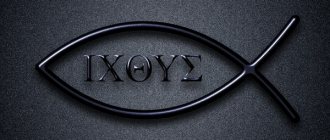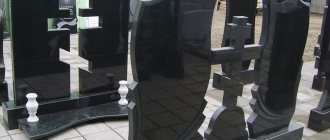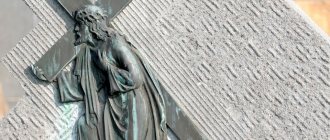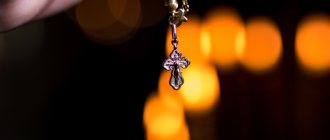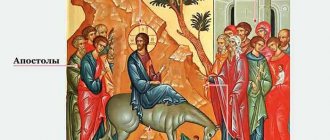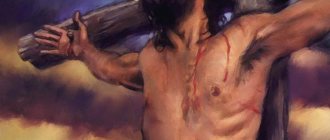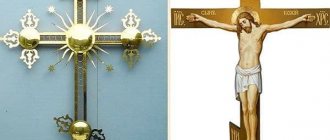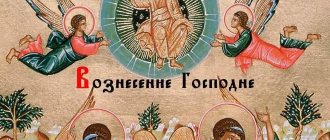Story
The cross has long indicated that its bearer belongs to Christians. The cross is revered by believers, because on it the Savior accepted martyrdom to atone for the sins of all mankind. This method of execution was popular in the Roman Empire of that time; previously such execution was considered shameful. After the suffering of Christ, the cross became a sign of victory and a reminder of the Savior’s endless love for people.
Important! The cross was sanctified by the blood of the Son of God. With his suffering, Christ closed the debt of humanity to the Almighty, voluntarily taking the guilt of all people onto his shoulders.
In Rus', the tradition of wearing a breast cross arose after Prince Vladimir recognized Christianity as the official religion of the Russian state. Many pagans did not want to be baptized and hid their religious beliefs.
The cross as a symbol is used in many religions
Then it was decided to give all those who were actually baptized small crosses, which they should always carry with them. This was the only way to distinguish a pagan from a Christian.
Important! Since then, only a baptized person has the right to wear a cross.
Traditional types of crosses
Crosses of various formats can be seen on the domes of churches, icons, church paraphernalia and as decorations. Modern Orthodox crosses, the types and meaning of which can vary, however, play an important role in the transmission of Orthodoxy throughout the world.
Four-pointed shape
This type of pectoral cross is most often found among Christians in the West. Such symbolism was found in the ruins of ancient Roman chapels, which is why Catholics still prefer this symbol of faith.
Eight-pointed shape
Such a cross is a traditional symbol of faith in Orthodoxy; it accurately reflects the cross on which the Savior accepted his death. The first crossbar depicts a sign with the name of Jesus Christ, the lower one - a footrest. The leg bar is always tilted to the left.
Eight-pointed pectoral cross
This is explained by the fact that the criminal, who was to the right of Christ, repented. The sinner recognized Christ as Lord and was awarded the Kingdom of Heaven. The second robber complicated his situation with criminal words. His unrepentant sins were the reason he went to hell.
Hexagonal shape
Similar symbolism was common among Christians of Ancient Rus'. It, like the eight-pointed one, has a crossbar for the legs. Its lower edge reminds of sins that pull the soul down to the underworld. The upper end symbolizes the liberation that a repentant sinner receives.
Important! The power of the cross does not lie in its appearance. His miraculousness lies in the power of the Son of God who conquered death. A cross of any form is recognized by the Church if it helps a person strengthen his faith.
Other forms of the cross
- T-shaped. During the years when the first Christians were persecuted for their faith, the letter T served as an image of the cross.
- Egyptian. It is similar to an Egyptian hieroglyph whose meaning is life. This symbol was often used by early Christians to prevent the familiar sign from attracting the attention of pagans.
Egyptian cross Ankh - Andreevsky. It looks like the letter X. According to legend, the Apostle Andrew ended his life on such a cross, so the cross was named in his honor.
- Monogrammed. Reminiscent of St. Andrew's cross, which is crossed in the middle by another line. Means the letters I and X, as a symbol of the name of the Savior.
- Monogram of Constantine. This cross was revealed to King Constantine during a night vision. The Lord commanded the ruler to protect himself from all evil. The symbol consists of the letters X and P, and means the word “Christ”.
- Sun-shaped. In it, the Constantine monogram is supplemented with the sign I.
- Catacomb. Archaeologists find such symbols in the paintings of ancient temples and in the catacombs where the first believers held services. Now the cross is used in the ornament that decorates the walls of the temple and church utensils.
- Seven-pointed. Found on ancient icons of northern writing.
- Crown of thorns. Such symbols were depicted in Christian manuscripts of ancient Armenia and on church attributes in Russia.
- Gallows-like. The symbol is used to decorate paraphernalia in the temple and the vestments of priests.
- Vine. “I am the vine, and you are the branches,” - this is what Christ said about himself. Since then, believers have associated the vine with the Sacrament of Communion, which allows believers to feel one with the Lord.
Pectoral cross Grapevine - Petal. Such a figure is often found in church fine art.
- Greek. A cross of a similar shape was installed by Prince Vladimir on the banks of the Dnieper, after returning from Constantinople. It is often inscribed in a circle depicting the celestial sphere.
- Nakupolny. A cross with a crescent crowning the domes of churches.
- Shamrock. The most common form of altar crosses.
- Georgievsky. Used on the handle of bishops' staffs. In addition, this form was used in the manufacture of the Order of St. George.
- Wicker. Ancient Christians made such crosses from mosaics and carved them from wood. Byzantine weaving decorates early printed books.
THE CROSS IS THE MAIN CHRISTIAN SYMBOL
Images of the cross have been found everywhere since ancient times. The squared cross, a symbol of earth and stability, represents the four cardinal directions or four regions of the world. A cross in a circle means the sun, fire. The cross is the center of the Universe, the cosmic axis, the cosmic Tree that connects Heaven with Earth. The cross expressed the inherent dualism and unity of opposites in nature. The vertical line is heavenly, spiritual, active, masculine. Horizontal - is earthly, rational, passive, feminine. Inextricably linked with the cross is the meaning of the crucifixion as the sacrifice of a savior, god or god-man.
The second meaning of the cross, where it acts as an instrument of shameful execution, prevailed in the first centuries of Christianity and obscured the ancient symbolism of the cross.
In the Christian East, images of the Crucifixion appear no earlier than the 6th century. The most famous is an illustration for the polemical work of the Greek monk Anastasius Sinaite. An eight-pointed cross is depicted here for the first time. The upper crossbar replaces the titlo, the arms are nailed to the middle one, and both legs are nailed to the lower one. Christ is depicted dead, bowing his head. The inscription on the cross is IC XC This miniature later became the prototype of most Byzantine and Russian Crucifixions.
THE CROSS OF EVERY FORM IS THE TRUE CROSS
There are several types of crosses that differ in their purpose. This is a simple monolithic body cross (vest), a breast or pectoral cross, an encolpion or a reliquary cross, consisting of two leaves with a cavity inside, an icon cross and an altar cross.
Body cross . The most widespread from ancient times to the present day is the custom of secretly wearing a cross under clothing. Such a cross is called a vest in Rus'. It is given by the Russian Orthodox Church to every Christian during the sacrament of Baptism. Using a cord or chain, they are worn around the neck and worn under clothing on the body. They are mainly made of copper and its alloys and are small in size (2.5-5 cm).
Pectoral crosses . When wearing a cross over clothing, the symbolism of Christian service becomes the main thing. In this case, a person shows that all his activities in the world are carried out under the banner of the cross and are a service to Christ. Therefore, breast crosses, worn over clothing, were in Rus' mainly an accessory of the episcopal rank, as well as obligatory items of princely and royal vestments, and were also used as a reward for clergy. They noted the chosenness of God and the Christian nature of spiritual and temporal power.
Encolpion. Reliquary cross . This type of cross came from Byzantium. It originated from a four-pointed box with an image of a cross on the lid, in which ancient Christians kept particles of holy relics or lists of sacred books. Later it acquired a cruciform shape. In Ancient Rus', folding reliquary crosses, along with other pectoral crosses worn over clothing, were items of princely and royal dignity. In addition, encolpions were sometimes worn by simple monastics, as well as pious laypeople, for example, pilgrims.
Kyoto cross . They differ from pectoral crosses in their larger size and do not have an eyelet for a neck cord. They were placed on special shelves (cases) among the holy icons in the red corner, and attached to the doorposts of the home. They were used to crown home iconostases and take them with them on travels, hikes, and trips to create temporary altars.
Altar cross . They are a necessary accessory of a Christian church. They are located on the altar throne next to the Gospel. Used during church services. They differ from pectoral and icon crosses in their larger sizes - from 30 cm and above.
Inscriptions on crosses
- On the top crossbar, which depicts a plate with the name of the convicted person, the symbols INCI are written. Since the procurator of Judea could not definitively determine the guilt of Christ, the tablet read “Jesus of Nazareth, King of the Jews.”
Pectoral cross with inscription - A Christogram is written on the middle crossbar, indicating the real name of Christ.
- Just below are the letters NIKA, which translate as “winner.”
What is the difference between an Orthodox cross and a Catholic one?
Many people, despite their Orthodox faith, do not know the difference between an Orthodox cross and a Catholic one. And so the difference between the Orthodox cross:
- An Orthodox cross has more than one crossbar. The classic version is an eight-pointed Orthodox cross, in the upper part of which there is a crossbar, which symbolizes a sign with an inscription. At the same time, the lower oblique crossbar symbolizes the board to which Christ’s feet were nailed. In the Catholic faith there is also an eight-pointed cross, but they depict crossbars that are not oblique, but strictly parallel to the top two.
- The body of the Savior is depicted on the cross. It seems to float freely next to the cross. At the same time, painful facial expressions are not depicted on the face. The stamp of painful suffering relates more to the Catholic canons.
- On the Orthodox cross, the legs of Christ are depicted closed, but on the Catholic cross they are depicted one on top of the other.
These are the main differences, knowing which you can easily distinguish an Orthodox cross from a Catholic one.
How to choose a pectoral cross for yourself
The assortment of pectoral crosses on the shelves of church shops and jewelry stores is huge, but often sellers themselves get confused in the variety of forms. Before purchasing, you should understand this issue, since the cross is not just a talisman or jewelry.
The Orthodox religion allows the use of any form of crosses; Catholicism traditionally welcomes the wearing of a four-pointed cross.
You can buy a cross:
- In a church shop or kiosk that sells church paraphernalia. They sell pre-consecrated crosses there. You can choose a cross made of noble metals, a simple metal cross or a wooden one. The cost of the cross does not matter and does not in any way affect the quality of life of its owner.
- In a jewelry store. You can choose a pectoral cross to suit your taste, and then take it to the nearest church and consecrate it.
The cross is a sign of belonging to Christianity
Many Orthodox crosses are devoid of jewelry delights. They are not decorations in the truest sense of the word. It is not for nothing that the cross is called a body cross - it is adjacent to the body and is often hidden under clothing. This is not a household attribute designed to decorate an everyday image, but a symbol of faith and belonging to Christianity.
On the other hand, making products from precious metals and decorating them with ornaments is not prohibited. There is no single canon regarding the size of the pectoral cross. Any product size will be acceptable.
Interesting to know! Sometimes believers say: “He bears his cross.” This phrase refers to the difficulties that a person faces throughout his life’s journey. Thus, carrying his cross, each person accomplishes a life feat in accordance with the commandments of God.
Consecration of the pectoral cross
Another very important issue is the consecration of the pectoral cross. If a cross is purchased at a temple shop, then it is usually consecrated. If the cross was purchased elsewhere or has an unknown origin, then it must be taken to the church, ask one of the temple servants or the worker behind the candle box to transfer the cross to the altar. After examining the cross and if it complies with Orthodox canons, the priest will serve the rite prescribed in this case. Usually the priest blesses the crosses during the morning prayer service. If we are talking about a baptismal cross for a baby, then consecration is possible during the Sacrament of Baptism itself.
When consecrating the cross, the priest reads two special prayers in which he asks the Lord God to pour heavenly power into the cross and that this cross will protect not only the soul, but also the body from all enemies, sorcerers and all evil forces. That is why many pectoral crosses have the inscription “Save and Preserve!”
In conclusion, I would like to note that the Cross must be revered with its correct, Orthodox attitude towards it. This is not just a symbol, an attribute of faith, but also an effective protection of a Christian from satanic forces. The cross must be honored both by actions, and by one’s humility, and by imitation of the Savior’s feat, as far as possible for a limited person. The rite of monastic tonsure says that a monk must always have the suffering of Christ before his eyes - nothing makes a person gather himself, nothing so clearly shows the need for humility as this saving memory. It would be good for us to strive for this. It is then that the grace of God will actually act in us through the image of the sign of the cross. If we do it with faith, we will truly feel God's power and know God's wisdom.
Material prepared by Ignatova Natalya
